A patient with unilateral facial droop and slurred speech has a history of hyperlipidemia and hypertension. The nurse should anticipate an order for a
A. head MRI.
B. triglyceride panel.
C. head and neck CT scan.
D. coagulation panel.
Explanation: Given the symptoms of unilateral facial droop and slurred speech, a stroke is highly suspected. A head and neck CT scan is the most appropriate initial imaging to quickly evaluate for the presence of an ischemic or hemorrhagic stroke, which is critical for determining the appropriate treatment plan. An MRI may provide more detailed information later but is not the initial test of choice in the acute setting. References: = CCRN Exam Handbook, AACN Adult CCRN Certification Review Course
A patient who is post repair of an abdominal aortic aneurysm should be monitored for which of the following complications?
A. acute renal failure
B. acute hepatic dysfunction
C. acute CVA
D. atrial fibrillation
Explanation:

Acute renal failure is one of the possible complications of abdominal aortic aneurysm (AAA)
repair, especially after open surgery. Acute renal failure is a sudden loss of kidney function
that can cause fluid and electrolyte imbalance, acid-base disturbance, and uremic
syndrome. Acute renal failure can occur due to several factors, such as hypoperfusion of
the kidneys, atheroembolism, contrast-induced nephropathy, or ischemia-reperfusion
injury12. The incidence of acute renal failure after AAA repair ranges from 2 to 25%,
depending on the definition, the type of surgery, and the patient’s risk factors13. Acute
renal failure is associated with increased morbidity, mortality, and length of hospital stay
after AAA repair13.
Other complications of AAA repair include bleeding, infection, wound complications, graftrelated
complications, bowel ischemia, spinal cord ischemia, and cardiac, pulmonary, or
neurological events124. Acute hepatic dysfunction, acute CVA, and atrial fibrillation are not
specific complications of AAA repair, but they may occur in any major surgery or in patients
with preexisting conditions.
An older adult patient is admitted with acute exacerbation of congestive heart failure. An echocardiogram indicates that EF is unchanged at 50%. The patient is most likely experiencing
A. heart failure with reduced EF.
B. heart failure with preserved EF.
C. left ventricular failure.
D. advanced heart failure.
Explanation: Heart failure with preserved ejection fraction (HFpEF) is a type of heart failure that occurs when the heart muscle is stiff and does not relax well, causing high pressure in the heart and lungs. HFpEF is diagnosed when the patient has symptoms and signs of heart failure and a normal or high ejection fraction (EF), which is the percentage of blood pumped out of the left ventricle with each heartbeat. HFpEF is usually caused by conditions that affect the heart or blood vessels, such as aging, high blood pressure, diabetes, obesity, or kidney disease12
A patient admitted with a diagnosis of pneumonia has a temperature of 103.2° F (39.5° C)
and copious pulmonary secretions. ABG results drawn on room air are:

The nurse should expect that hemoglobin's affinity for oxygen in this patient to be
A. unchanged.
B. unpredictable.
C. increased.
D. decreased.
Explanation: The patient's ABG results indicate respiratory acidosis (pH 7.33, PaCO2 48 mm Hg) with a slightly elevated temperature (103.2° F). In the context of fever and acidosis, hemoglobin's affinity for oxygen decreases, a phenomenon described by the Bohr effect. This means that hemoglobin will release oxygen more readily to the tissues. Factors like increased temperature and acidosis cause a rightward shift in the oxyhemoglobin dissociation curve, reducing the affinity of hemoglobin for oxygen.References: = CCRN Exam Handbook, page 44
A patient who sustained a C4 fracture requests to be taken off the ventilator 3 days after the initial injury, indicating, "I can't live hooked to this machine." The nurse's best response to this patient would be,
A. "Do you feel that you will be hooked up to this machine forever?"
B. "Eventually your diaphragm will regain its function, allowing you to breathe independently."
C. "Many quadriplegics live fulfilling lives as they adjust to their new lifestyle."
D. "After you have started the rehabilitation process, your outlook will improve."
Explanation: The best response is to assess the patient's feelings and understanding of their condition and prognosis. This response opens a dialogue and allows the nurse to provide education and emotional support based on the patient's specific concerns. Other responses may provide false reassurance or imply assumptions about the patient’s future without first understanding their current emotional state and concerns. References: AACN Adult CCRN Certification Review Course, AACN CCRN Exam Handbook.
A family member asks permission to visit a patient after work at 12:30 AM. On previous visits, the family member has been disruptive. To address the situation, a nurse should
A. ask the family member to visit during scheduled visiting hours.
B. ask the family member to visit before work.
C. not allow the visit, as the patient will be sleeping.
D. allow the family member to visit after setting behavioral limits.
Explanation: While it is important to support family involvement, previous disruptive behavior necessitates setting clear behavioral limits to ensure a safe and therapeutic environment for the patient. Allowing the visit with established guidelines helps balance the need for patient support with maintaining unit order. This approach also respects the patient's rest and recovery needs. References: = CCRN Exam Handbook, AACN Adult CCRN Certification Review Course
A patient presents with fever and chills, is diaphoretic, and reports experiencing abdominal
and intermittent left shoulder pain for the past week. An
ultrasound shows an enlarged spleen. Vital signs are:
BP 106/59
HR 118
RR 23
T101.2° F (38.4° C)
When reviewing the lab report, which of the following findings is most significant to this
presentation?
A. positive blood cultures
B. PLT 150,000/mm3
C. WBC less than 500/mm3
D. Hct 39%
Explanation:

The patient’s presentation is suggestive of splenic abscess, which is a rare but serious
complication of splenomegaly. Splenic abscess is caused by bacterial or fungal infection of
the spleen, usually from hematogenous spread or contiguous spread from adjacent organs.
The most common symptoms are fever, chills, abdominal pain, and left shoulder pain (Kehr
sign). The most significant laboratory finding is positive blood cultures, which indicate
systemic infection and sepsis. Other laboratory findings may include leukocytosis, anemia,
thrombocytopenia, elevated inflammatory markers, and abnormal liver function tests.
However, these are nonspecific and may vary depending on the underlying cause of
splenomegaly and the type of microorganism involved.
A patient who was admitted after an open aortofemoral bypass for claudication at rest has a hemoglobin A1C of 8.9. The patient admits having poor control of blood glucose levels and is scared to use insulin as directed because of a few episodes of hypoglycemia. Which of the following should the nurse initially request to be consulted?
A. endocrinology
B. diabetes educator
C. hospital pharmacist
D. vascular surgeon
Pulsus paradoxus is defined as
A. a decrease in systolic BP of greater than 10 mm Hg during normal expiration.
B. a decrease in systolic BP of greater than 10 mm Hg during normal inspiration.
C. a decrease in diastolic BP of greater than 10 mm Hg during normal expiration.
D. an increase in systolic BP of greater than 10 mm Hg during normal inspiration.
Explanation: Pulsus paradoxus is defined as a decrease in systolic blood pressure (BP) of more than 10 mm Hg during normal inspiration. This phenomenon occurs due to the increased negative intrathoracic pressure during inspiration, which exaggerates the normal drop in systolic BP. It is often seen in conditions such as cardiac tamponade, constrictive pericarditis, and severe asthma or COPD exacerbations. References: = CCRN Exam Handbook, AACN Adult CCRN Certification Review Course
A patient with a history of alcohol abuse has been admitted for progressive dyspnea and
leg swelling. Assessment findings include:
BP155/90
HR85
CVP12 mm Hg
Which of the following tests will provide the most definitive diagnosis?
A. echocardiogram
B. pro-BNP
C. chest x-ray
D. liver function panel
Examination of a patient exhibiting Kernig's and Brudzinski's signs indicates which of the following?
A. autonomic hyperreflexia
B. adrenal insufficiency
C. meningeal irritation
D. increased intracranial pressure
Explanation: Kernig's and Brudzinski's signs are classic clinical indicators of meningeal irritation, commonly associated with conditions such as meningitis. Kernig's sign is positive when there is resistance and pain upon extending the knee from a flexed position, and Brudzinski's sign is positive when flexion of the neck causes involuntary flexion of the hips and knees. These signs are not indicative of autonomic hyperreflexia, adrenal insufficiency, or increased intracranial pressure. References: = CCRN Exam Handbook, AACN Adult CCRN Certification Review Course
A patient is admitted with hypotension, tachycardia, and intermittent confusion. Upon arrival, the patient asks to walk to the bathroom. Which of the following is a nurse's best action?
A. Assess the patient's vital signs and ask the physician for an order for activity.
B. Conduct a fall risk assessment and institute appropriate interventions.
C. Encourage the patient to walk independently to the bathroom to enhance early mobility.
D. Situate the patient in bed and provide a bed pan.
Explanation: Given the patient's symptoms of hypotension, tachycardia, and intermittent confusion, the safest course of action is to keep the patient in bed to prevent falls and further injury. The patient is at high risk for falls due to their hemodynamic instability and altered mental status. Using a bed pan minimizes the risk of injury compared to allowing the patient to walk, which could lead to falls and worsen their condition. References: = CCRN Exam Handbook, AACN Adult CCRN Certification Review Course
| Page 3 out of 13 Pages |
| Previous |